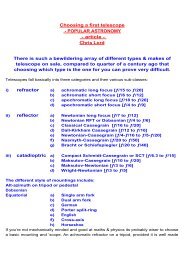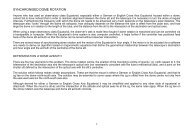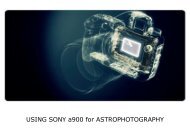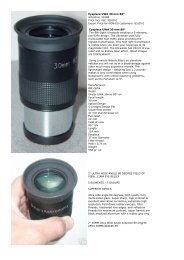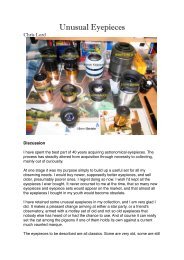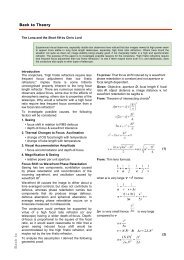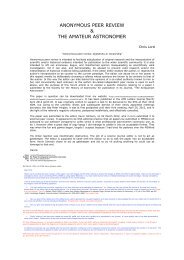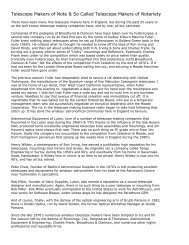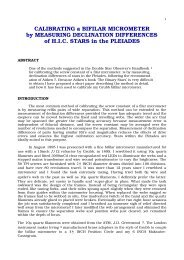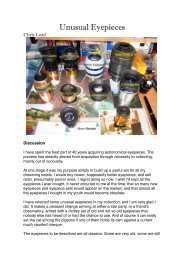Evolution of the Astronomical Eyepiece - Brayebrook Observatory
Evolution of the Astronomical Eyepiece - Brayebrook Observatory
Evolution of the Astronomical Eyepiece - Brayebrook Observatory
You also want an ePaper? Increase the reach of your titles
YUMPU automatically turns print PDFs into web optimized ePapers that Google loves.
SURFACE QUALITY OF OPTICAL ELEMENTS<br />
Surface Quality refers to <strong>the</strong> cosmetic features <strong>of</strong> an optical element in terms <strong>of</strong> <strong>the</strong><br />
amount <strong>of</strong> defects that can be visually inspected on <strong>the</strong> element’s surface. A scratch is<br />
any mark or tear on <strong>the</strong> surface and a dig is any pit or divot in <strong>the</strong> surface. The Scratch-<br />
Dig specification defines <strong>the</strong> quality <strong>of</strong> a polished surface.<br />
Scratches and Digs are defined by <strong>the</strong> U.S. Mil.SPEC. MIL-0-13810A. Scratch numbers<br />
are essentially defined by <strong>the</strong> width <strong>of</strong> a scratch in 1/10,000mm (0.1µm). However <strong>the</strong><br />
lengths <strong>of</strong> scratches and combinations <strong>of</strong> smaller scratches also contribute to <strong>the</strong> scratch<br />
number. Dig numbers are defined by <strong>the</strong> actual diameter <strong>of</strong> a dig in 1/100mm (10µm).<br />
Smaller digs and irregularly shaped digs also affect <strong>the</strong> dig number. Specification <strong>of</strong> optical<br />
surface quality is denoted by <strong>the</strong> scratch number followed by <strong>the</strong> dig number. For<br />
example a scratch-dig ratio <strong>of</strong> 60-40 is acceptable in commer cial eyepiece optics.<br />
Typical scratch-dig ratios, from <strong>the</strong> highest quality essential for scatter free lenses,<br />
through to <strong>the</strong> minimum acceptable quality suitable in emitter-detector optics are:<br />
SCRATCH No.: 10; 20; 40; 60; 80; 120; 160.<br />
DIG No.: 05; 10; 20; 40; 50; 70; 100.<br />
<strong>the</strong> higher <strong>the</strong> scratch and dig numbers <strong>the</strong> lower <strong>the</strong> surface quality.<br />
54



